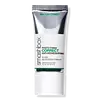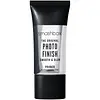What's inside
What's inside
 Key Ingredients
Key Ingredients

 Benefits
Benefits

 Concerns
Concerns

 Ingredients Side-by-side
Ingredients Side-by-side

Water
Skin ConditioningDimethicone
EmollientVinyl Dimethicone/Methicone Silsesquioxane Crosspolymer
Methyl Trimethicone
Skin ConditioningButylene Glycol
HumectantDimethicone/Vinyl Dimethicone Crosspolymer
Skin ConditioningGlycerin
HumectantSilica
AbrasiveHydroxyethyl Urea
HumectantAlgae Extract
EmollientRosa Hybrid Flower Extract
Skin ConditioningFuscoporia Obliqua Sclerotium Extract
Skin ConditioningLycium Chinense Fruit Extract
AntioxidantLactobacillus Ferment
Skin ConditioningVaccinium Angustifolium Fruit Extract
Skin ProtectingVaccinium Macrocarpon Fruit Extract
AstringentPoria Cocos Sclerotium Extract
AstringentCaffeine
Skin ConditioningYeast Extract
Skin ConditioningSorbitol
HumectantSodium Polyaspartate
HumectantEthylhexylglycerin
Skin ConditioningPantethine
EmollientTrehalose
HumectantSodium Hyaluronate
HumectantIsohexadecane
EmollientIsopropyl Isostearate
EmollientPPG-15 Stearyl Ether
EmollientPEG-8 Dimethicone
EmulsifyingPolyglyceryl-3 Disiloxane Dimethicone
Skin ConditioningPolyglyceryl-3 Polydimethylsiloxyethyl Dimethicone
Skin ConditioningTrimethylsiloxysilicate
EmollientAmmonium Acryloyldimethyltaurate/Vp Copolymer
Acrylamide/Sodium Acryloyldimethyltaurate Copolymer
Emulsion StabilisingPolysorbate 80
EmulsifyingDisodium EDTA
Tin Oxide
AbrasiveCellulose
AbsorbentSynthetic Fluorphlogopite
Triethoxycaprylylsilane
Tocopheryl Acetate
AntioxidantTocopherol
AntioxidantBHT
AntioxidantSodium Dehydroacetate
PreservativePotassium Sorbate
PreservativePhenoxyethanol
PreservativeCI 77891
Cosmetic ColorantCI 77288
Cosmetic ColorantMica
Cosmetic ColorantCI 77163
Cosmetic ColorantCI 77492
Cosmetic ColorantWater, Dimethicone, Vinyl Dimethicone/Methicone Silsesquioxane Crosspolymer, Methyl Trimethicone, Butylene Glycol, Dimethicone/Vinyl Dimethicone Crosspolymer, Glycerin, Silica, Hydroxyethyl Urea, Algae Extract, Rosa Hybrid Flower Extract, Fuscoporia Obliqua Sclerotium Extract, Lycium Chinense Fruit Extract, Lactobacillus Ferment, Vaccinium Angustifolium Fruit Extract, Vaccinium Macrocarpon Fruit Extract, Poria Cocos Sclerotium Extract, Caffeine, Yeast Extract, Sorbitol, Sodium Polyaspartate, Ethylhexylglycerin, Pantethine, Trehalose, Sodium Hyaluronate, Isohexadecane, Isopropyl Isostearate, PPG-15 Stearyl Ether, PEG-8 Dimethicone, Polyglyceryl-3 Disiloxane Dimethicone, Polyglyceryl-3 Polydimethylsiloxyethyl Dimethicone, Trimethylsiloxysilicate, Ammonium Acryloyldimethyltaurate/Vp Copolymer, Acrylamide/Sodium Acryloyldimethyltaurate Copolymer, Polysorbate 80, Disodium EDTA, Tin Oxide, Cellulose, Synthetic Fluorphlogopite, Triethoxycaprylylsilane, Tocopheryl Acetate, Tocopherol, BHT, Sodium Dehydroacetate, Potassium Sorbate, Phenoxyethanol, CI 77891, CI 77288, Mica, CI 77163, CI 77492
Cyclopentasiloxane
EmollientDimethicone
EmollientDimethicone Crosspolymer
Emulsion StabilisingTrisiloxane
Skin ConditioningSilica
AbrasiveDimethicone/Vinyl Dimethicone Crosspolymer
Skin ConditioningEthylhexyl Salicylate
UV AbsorberRetinyl Palmitate
Skin ConditioningTocopheryl Acetate
AntioxidantCarthamus Tinctorius Seed Extract
Skin ConditioningPropylene Glycol
HumectantWater
Skin ConditioningVitis Vinifera Seed Extract
AntimicrobialCola Acuminata Seed Extract
Skin ConditioningCamellia Oleifera Leaf Extract
AstringentCyclopentasiloxane, Dimethicone, Dimethicone Crosspolymer, Trisiloxane, Silica, Dimethicone/Vinyl Dimethicone Crosspolymer, Ethylhexyl Salicylate, Retinyl Palmitate, Tocopheryl Acetate, Carthamus Tinctorius Seed Extract, Propylene Glycol, Water, Vitis Vinifera Seed Extract, Cola Acuminata Seed Extract, Camellia Oleifera Leaf Extract
 Reviews
Reviews

Ingredients Explained
These ingredients are found in both products.
Ingredients higher up in an ingredient list are typically present in a larger amount.
Dimethicone is a type of synthetic silicone created from natural materials such as quartz.
What it does:
Dimethicone comes in different viscosities:
Depending on the viscosity, dimethicone has different properties.
Ingredients lists don't always show which type is used, so we recommend reaching out to the brand if you have questions about the viscosity.
This ingredient is unlikely to cause irritation because it does not get absorbed into skin. However, people with silicone allergies should be careful about using this ingredient.
Note: Dimethicone may contribute to pilling. This is because it is not oil or water soluble, so pilling may occur when layered with products. When mixed with heavy oils in a formula, the outcome is also quite greasy.
Learn more about DimethiconeThis ingredient is a silicone used to improve the texture of products and absorb oil. It does not get absorbed into the skin.
Like other silicones, Dimethicone/Vinyl Dimethicone Crosspolymer helps condition the skin by creating a barrier. In this sense, it can act as an emollient and trap moisture in.
This ingredient is a type of elastomer.
Learn more about Dimethicone/Vinyl Dimethicone CrosspolymerSilica, also known as silicon dioxide, is a naturally occurring mineral. It is used as a fine, spherical, and porous powder in cosmetics.
Though it has exfoliant properties, the function of silica varies depending on the product.
The unique structure of silica enhances the spreadability and adds smoothness, making it a great texture enhancer.
It is also used as an active carrier, emulsifier, and mattifier due to its ability to absorb excess oil.
In some products, tiny microneedles called spicules are made from silica or hydrolyzed sponge. When you rub them in, they lightly polish away dead skin layers and enhance the penetration of active ingredients.
Learn more about SilicaTocopheryl Acetate is AKA Vitamin E. It is an antioxidant and protects your skin from free radicals. Free radicals damage the skin by breaking down collagen.
One study found using Tocopheryl Acetate with Vitamin C decreased the number of sunburned cells.
Tocopheryl Acetate is commonly found in both skincare and dietary supplements.
Learn more about Tocopheryl AcetateWater. It's the most common cosmetic ingredient of all. You'll usually see it at the top of ingredient lists, meaning that it makes up the largest part of the product.
So why is it so popular? Water most often acts as a solvent - this means that it helps dissolve other ingredients into the formulation.
You'll also recognize water as that liquid we all need to stay alive. If you see this, drink a glass of water. Stay hydrated!
Learn more about Water